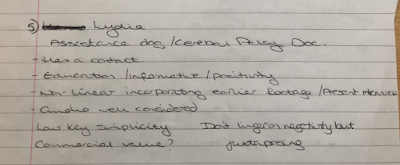Course Work- Sound Application
The non-diegetic sound that I will include will be music in the background. This music will change along with the mood. I will do this to empathise the emotions more. For example, I could put a slow, sombre piece of piano music in where the documentary looks at how hard it was without an assistance dog. Then later on I will use a more happy, upbeat piece of music when it is being reflected on the positive impact an assistance dog has had. After watching lots of short documentaries I realised that most of them work well with a narration over the top. So I may also include this during archive footage. Or I may include the audio from the interview part of my documentary, then the cutting between both shots will be smoother. I may also include times of complete silence where she is reflecting on a difficult time. Then the audience will be able to just focus on her emotions and nothing else. In certain parts, I will also make sure to keep in the ambient sound. This...


